Ep. 38: RaW Hero vol 1, by Akira Hiramoto
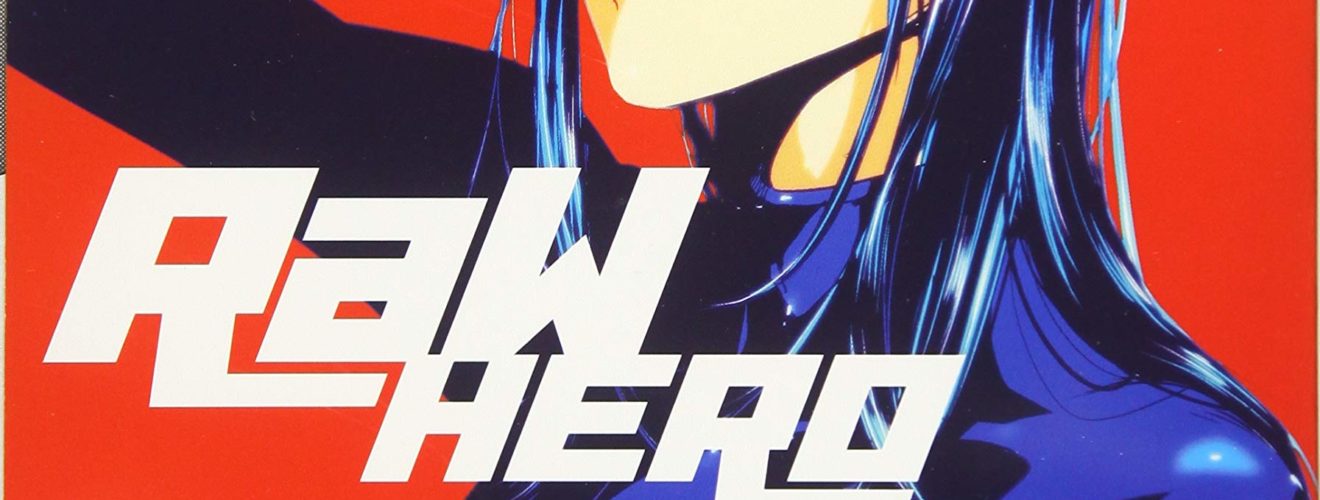
Sometimes manga is sexy. Sometimes, it’s “sexy.” And sometimes, just sometimes, it’s RaW Hero Volume 1.
This episode and these show notes are extremely NSFW.
Powered by RedCircle
This Episode:
00:00 RaW Hero Vol 1, by Akira Hiramoto
54:54 THE BREAK!
55:20 Q&A: Do manga creators get influenced by Western comics creators?
1:09:00 Shout-outs!
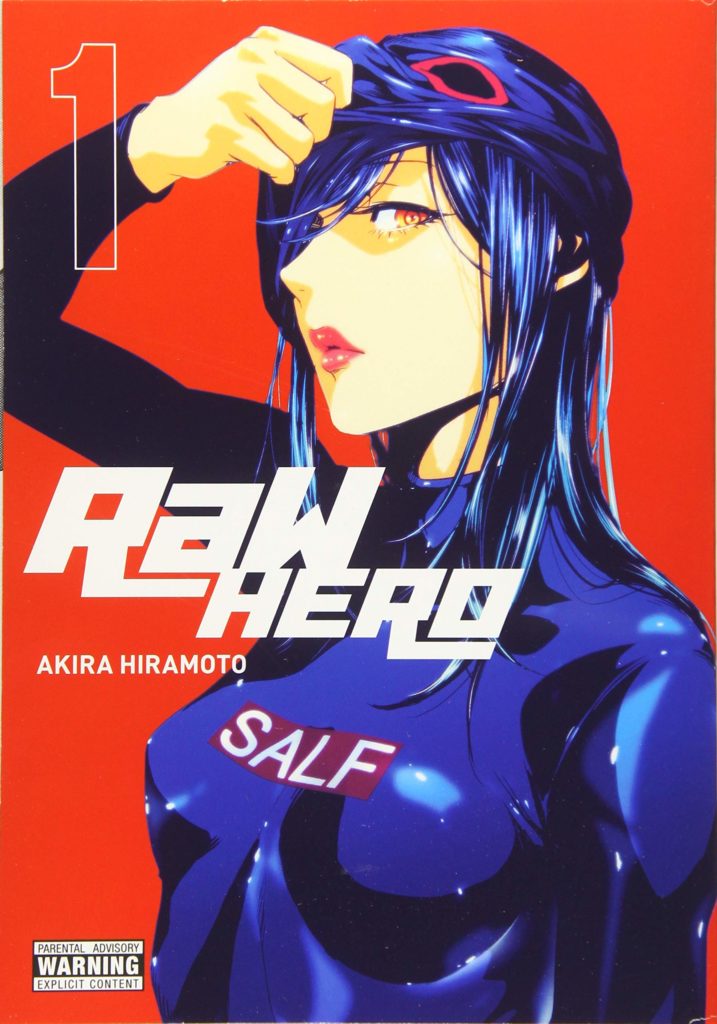
RaW Hero Vol. 1
By Akira Hiramoto
Translated by Ko Ransom
Lettered by Phil Christie
Published by Yen Press
Show notes by Christopher Butcher and Deb Aoki. Audio editing by David Brothers.
Content Warning: “Shady [Sleazy] Sexual Stuff Going On.” This is an exploitation manga firmly in the vein of trash cinema and exploitation movies. Listener (and reader!) discretion is advised.
00:00 We totally forget to actually explain what RaW Hero is about. Damn, we were doing so well. So, here’s an edited version of the back-of-the-book description from Yen Press, which actually explains what happens in this book. Because without context, we all just kind of sound crazy.
A portion of humanity has obtained special abilities, and two groups emerge in conflict. On the side of justice are “heroes.” On the side of villainy are “monsters.” For Chiaki, however, all that matters is finding work to support his younger brothers, and their dream of living in a beautiful high-rise condo! But on a train ride to his latest job interview he intervenes in a train-groper incident… only to discover that this couple is fully consenting and taking their kinks public! Moreover, the groper himself is a secret agent for the “Heroes,” and Chiaki accepts an assignment that sees him infiltrating the “monsters”… dressed like a 16 year old girl. Will he be found out by the “Monsters?” Will he help stop their dastardly schemes? Or are the kinky public sexual behaviours just the tip of the iceberg for what the “Heroes” are really all about?
If the back of the book text was 400 words.
02:00 [Deb:] I actually meant it was “wrapped for your PROTECTION.” Oh well. In case you don’t know, a lot of manga published in N. America that is kind of… well, not appropriate for the kiddies to flip through at the bookstore come shrink-wrapped. RaW Hero is one such manga.
02:53
03:23 So as I say here, Raw Hero, to me, is like if Takashi Miike made a Marvel movie. It’s way, way too much, and you’re either on board or you’re not. We talk a little bit about it later.
[Deb:] In case you’re not familiar with the work of “trash cinema auteur” Takashi Miike, go take a look at his IMDb page — he is maybe best known for his movies like Ichi the Killer (a yakuza movie with some S/M ultra violent twists) and more recently he HAS directed several movies based on manga, including the live-action version of Jojo’s Bizarre Adventure: Diamond is Unbreakable (available on DVD and Blu-Ray from VIZ Media) and putting his own twisted take on superhero stories with Yatterman.
05:52 We come back to the Elephant Blowjob. A lot. It’s a lot.
06:30 Hope you kept listening. We need the boost to our metrics. Like and subscribe and leave reviews, folks!
09:41 So we had some major technical issues with this episode, Due to some terrible internet situations in the Bay Area of California. We took a 20 minute break, rebooted all of our stuff, and gave it a shot. It didn’t end up working out, as you’ll see in a moment.
11:00 [Deb:] The boss hears the news, then gets into a car crash scenes in RaW Hero volume 2:
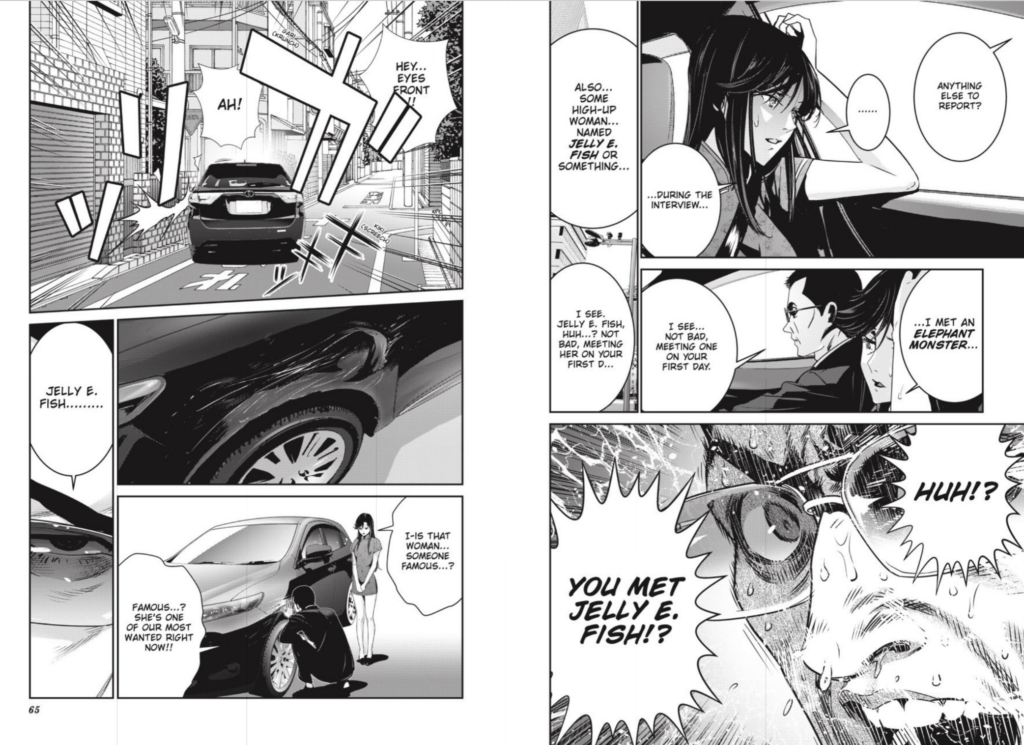
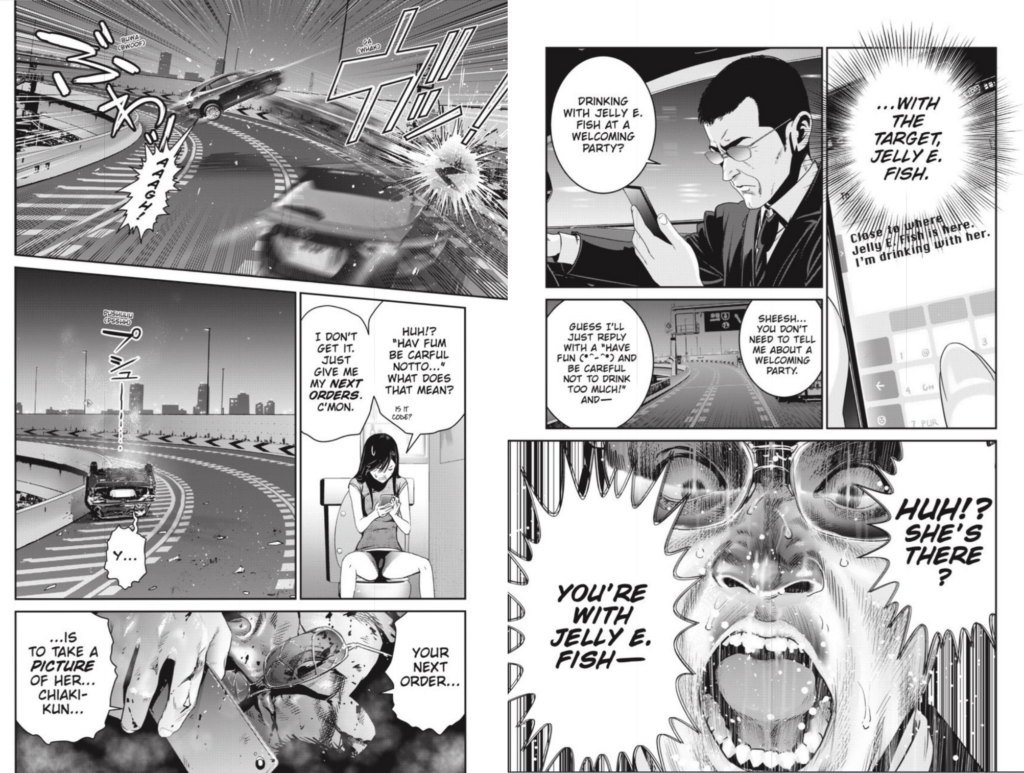
11:48 Coming out of a sushi bar in the middle of a fight, also from RaW Hero volume 2:
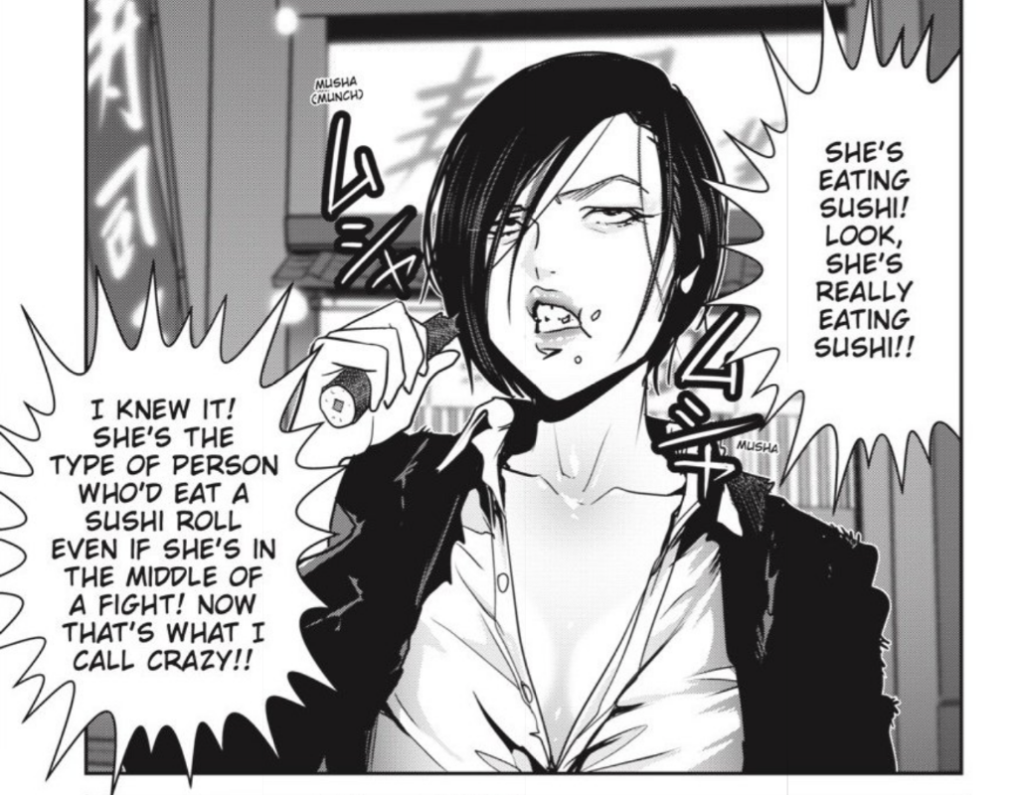
11:50 Laugh-crying and saying “This is… clever…. but I’m still cringing” is like, the best description of this series. Bravo, Deb. Worth the wait!
13:28
“This is the Las Vegas of comics.”
Deb Aoki and Chip Zdarsky, on RaW Hero Vol. 1
14:45 So as described, this series is from the creator of the infamous manga series Prison School, a manga and anime series about a very strict all-girl’s school allowing boys into their system for the first time. The school has a prison by the way, and any infraction gets you sent to that prison. The girls do not want the boys there, and between the boys’ (inevitable) horniness and the girls’ strictness, the boys are incarcerated, humiliated, and… of course… turned on by the punishment. This went on for TWENTY-EIGHT VOLUMES. Only one season of anime though.
[Deb:] Fans may disagree, but maybe one season of the anime was enough. Funimation has the Prison School anime streaming online, and has it on Blu-ray/DVD too. Here’s a taste:
All 28 volumes were published in English as fourteen 2-in-1 omnibus editions by Yen Press, but they are largely out of print (and unlikely to be reprinted).
15:54 Welp, the internet FINALLY gave up the ghost here, and we decided to call it a night. I kind of thought that maybe discussing this episode was cursed… But we soldiered on! We took a week-long break at the sound of the chimes, and came back with Deb asking the questions about Japanese sentai super heroes. It’s interesting, because I think all of our opinions changed a little bit for having an extra week to ‘ruminate’ on this particular title.
16:30 Elephant Trunk Blow Job. We’re not gonna show it, but we’re gonna show you just before it happens.
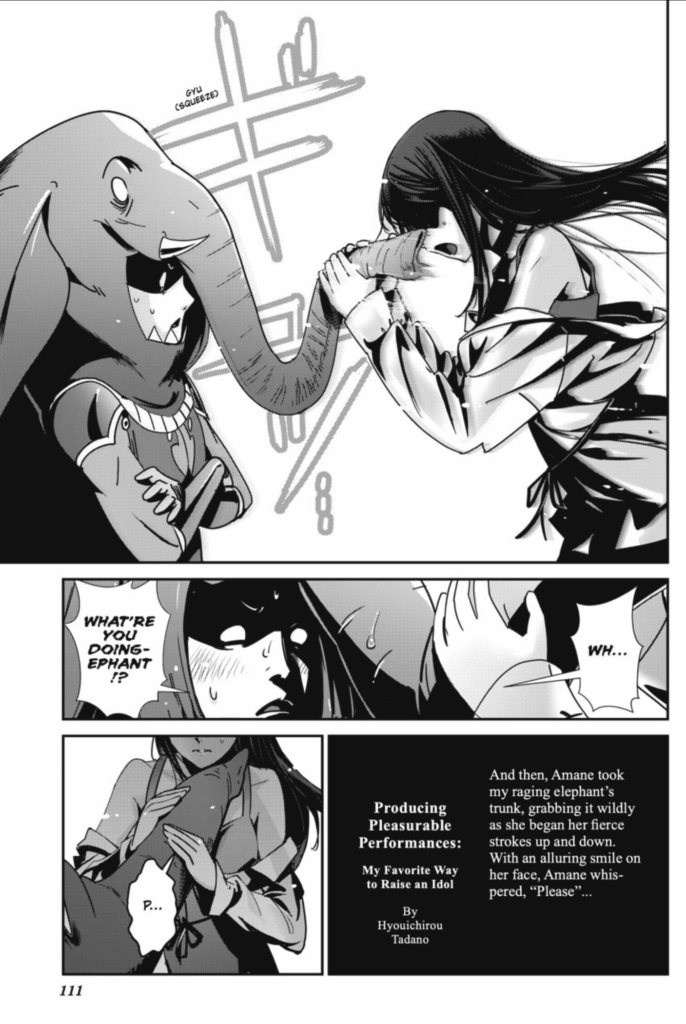
16:45 Kamen Rider is a series television series’ based on the original manga by Shotaro Ishinomori, that debuted in 1971. We’re actually going to read the original Kamen Rider manga coming up in a few weeks. But to Deb’s point, Kamen Rider is a bit like a Japanese Spider-Man, a masked grasshopper-themed vigilante with a power-granting Rider Belt that gives him enhanced speed, strength, and durability. He rides around on a kick-ass motorcycle. Also, like Spider-Man, all of his enemies tend to have an animal theme as well. Colonel Zol (aka Wolf Man), Doctor Death (aka Squidevil), Ambassador Hell (aka Rattlander), etc. So the elephant-themed villain in this manga is… well, it’s right on par with Japanese super-heroes and super-villains.
19:05 Okay, so Elephant Man. His speech patterns, with the “-ephant” at the end of every sentence as his ‘tic’, his ridiculous headpiece that is completely in line with Marvel and DC animal-themed heroes of this type. He’s great.
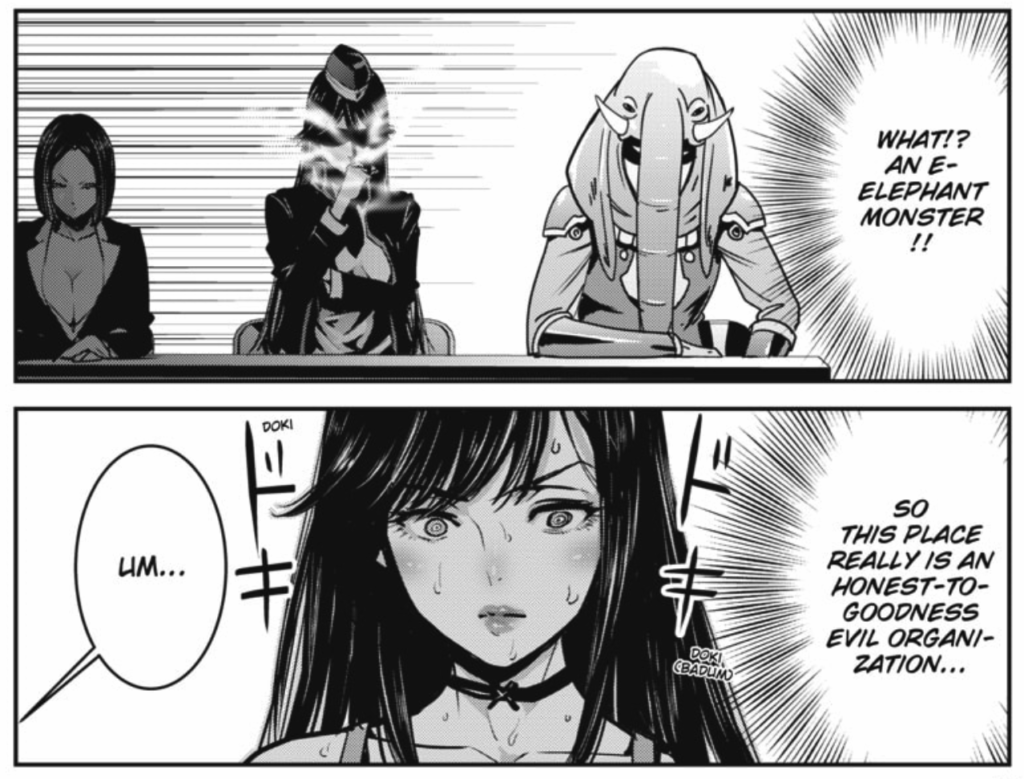
19:43 And while reading this, I couldn’t help but think of Razorback from Marvel Comics.
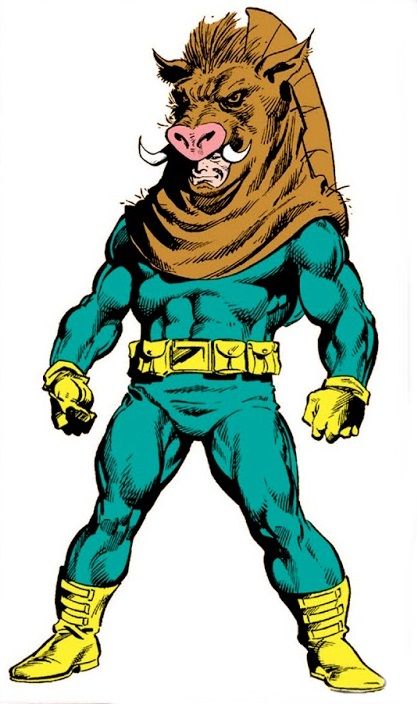
Like, tell me that this dude isn’t wearing the exact same costume as The Elephant. Tell me that his line-of-sight isn’t just as impaired by that boar snout as The Elephant is by his trunk! Tell me he isn’t wearing that headpiece in bed! About the only difference is his build–he’s got the typical Marvel exaggerated strongman build, instead of Japan’s more slender heroic forms. We talk a little about that later in the episode.
20:10 His strange speech-pattern is great.
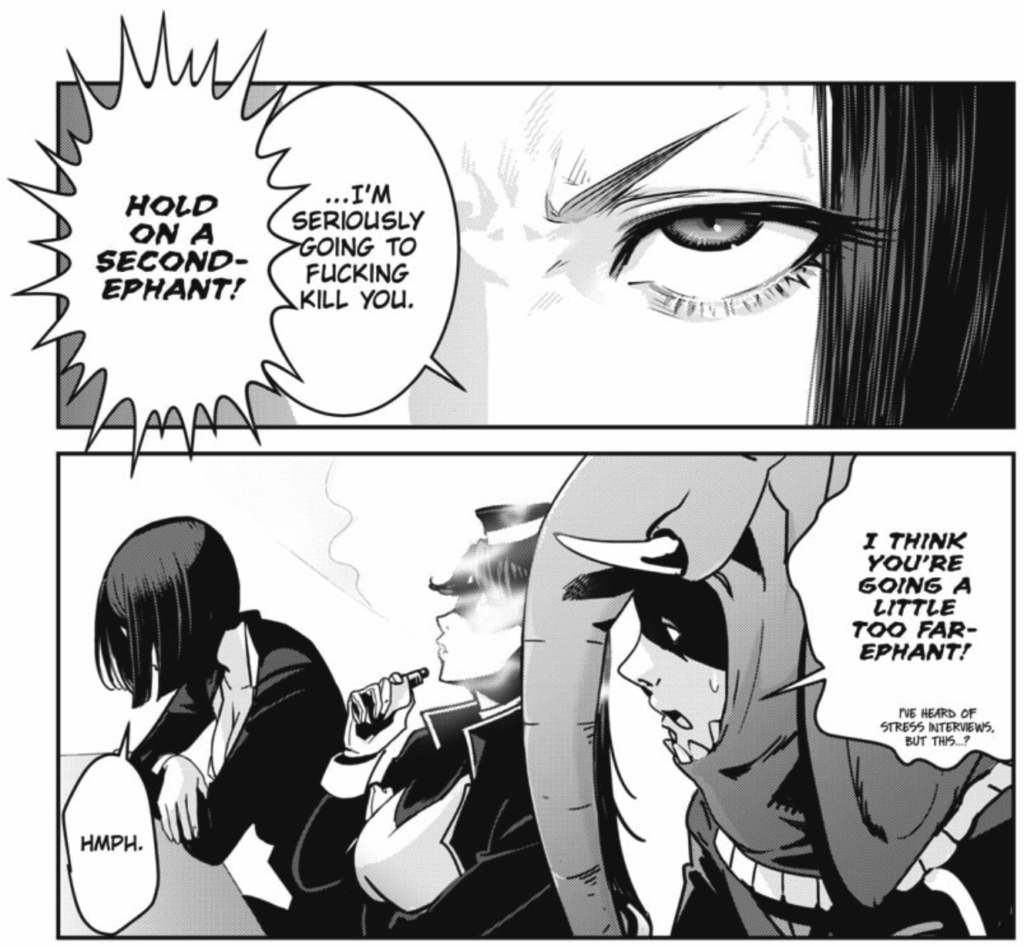
21:50 Takashi Miike. So the film I was thinking of by Miike is Dead or Alive. If you’ve seen it, you’ll know exactly what I’m talking about. If you haven’t seen it, man, I don’t know if I can recommend it at all but you’ve never seen anything like it, and maybe that’s for you.
Maybe you’re not gonna track down this movie, it’s probably difficult to find. So, here’s the first 6 minutes. It was on YouTube. You need to sign-in to your age-verified Youtube account to watch it. LOL. https://www.youtube.com/watch?v=TM65MPPn4PA
Also, shout-out to Colin Geddes and Midnight Madness at TIFF.
26:00 The team shot is crazy. Foreigner, Dog, schlubby Ryu, cross-dressing government mole.
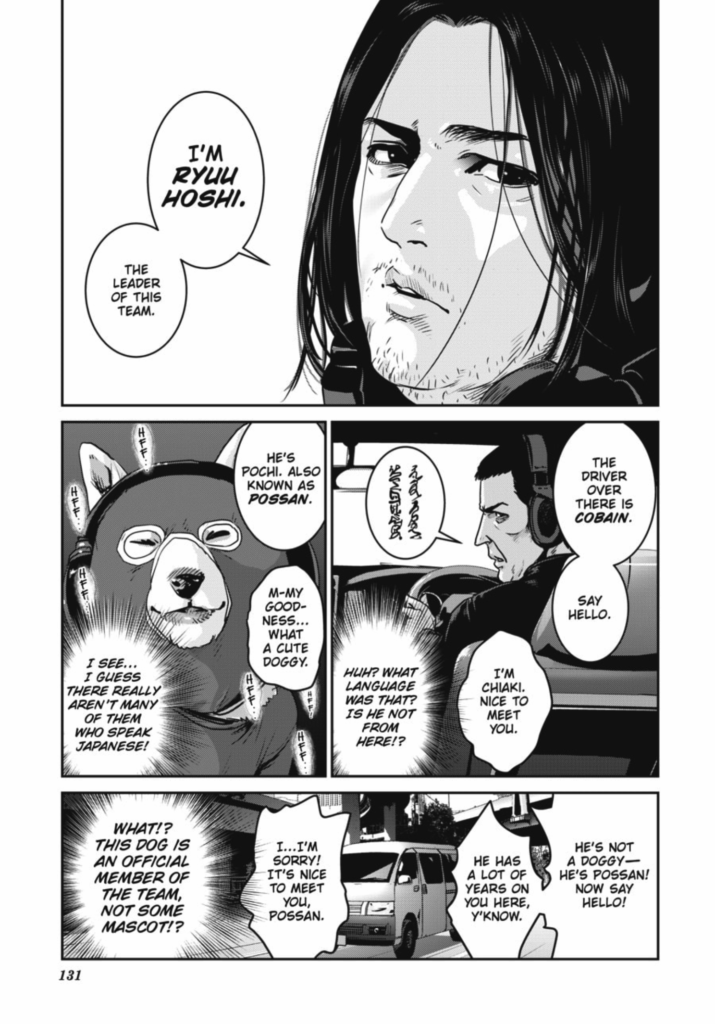
26:19 So Ryuu Hoshi is fascinating. Because that’s the surname that was given to Ryu from Street Fighter in the American movie (starring Jean-Claude Van Damme as Guile). So if this IS a reference to that Ryu Hoshi, but the American version, the schlubbiness of his portrayal is a real good joke. Probably the one thing that let me down in this manga is that he’s drawn really chubby in his first appearance above, but is just an average, even skinny, guy in the rest of his appearances.
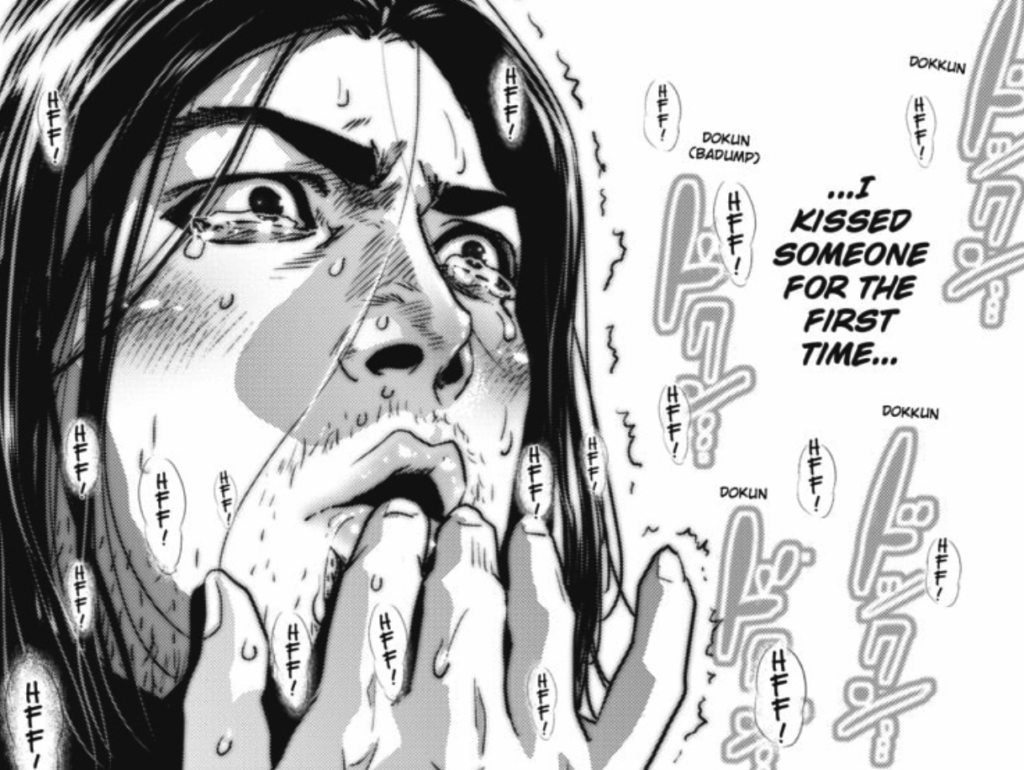
26:45 Supervillains committing… graffiti! Oh, Japan.
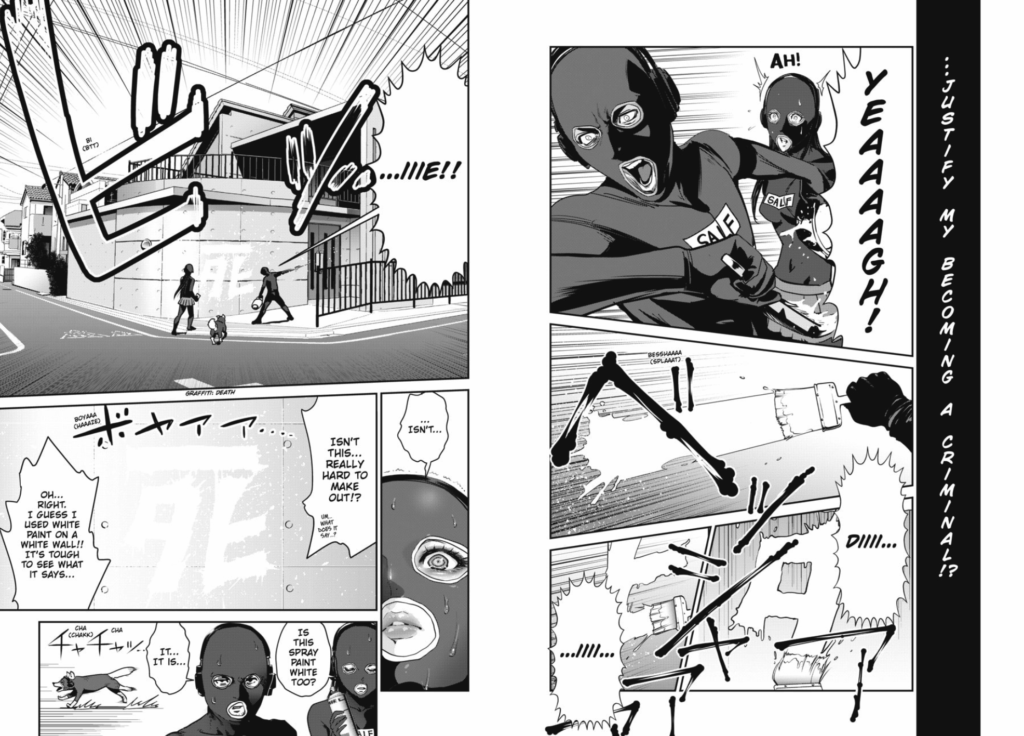
27:30 Man, I wish I’d jumped in to explain that humiliation and trust are sort of tied together (lol) in the sort of sexual situation going on in this manga, specifically around forced feminization porn. Although this isn’t porn? It’s just sort of… ecchi? Sleazy? There’s maybe very little like this in North American art, we’re maybe just too hung up about sex? And Deb has been kind of clear about this throughout this episode too, this is about men being humiliated by people that they trust, about exhibitionism and voyeurism, about all of that, and it seems to be a running theme (gag?) in Hiramoto’s manga.
29:00 The camel-toe is real. Page 140-141.
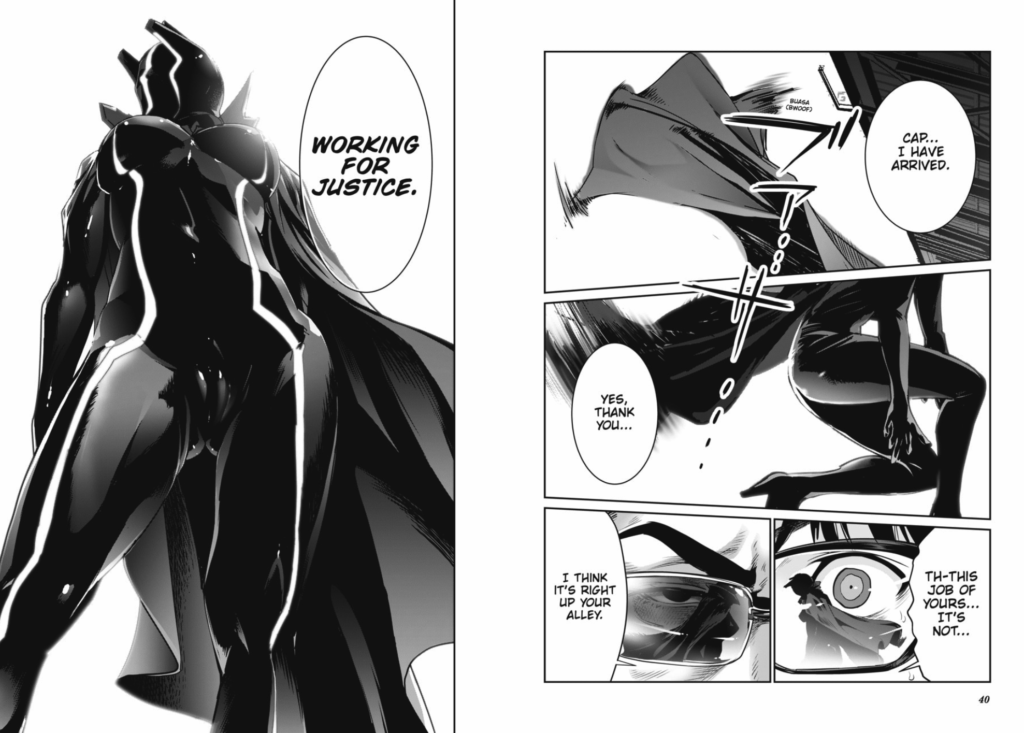
29:40 This shot, of the ‘goal’ (high-rise condo) framed by what the lead character is willing to do to get it (upskirt panty shot). This is really, really just good comics storytelling.
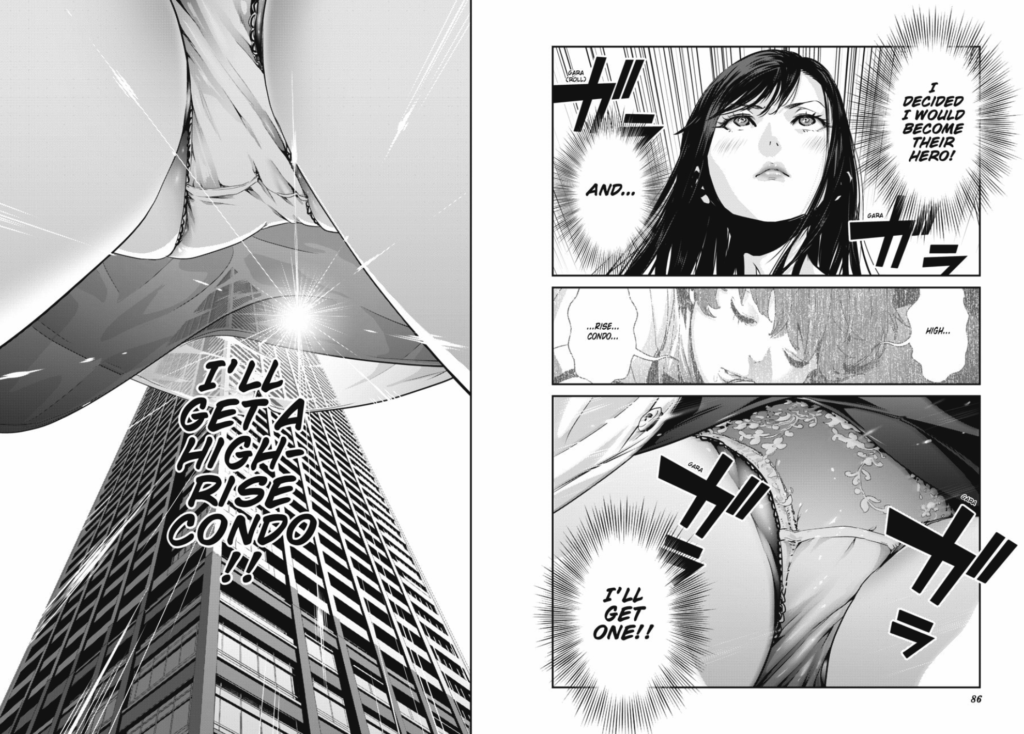
32:45 So going back even a little bit further, Akira Hiramoto created the historical fiction title Me and the Devil Blues, about legendary blues musician Robert Johnston’s supposed ‘Deal with the Devil.’ It’s factually-based and then goes off into the supernatural and psychological horror.
It’s the rare manga that has a shitty publication history in both North America AND Japan! In Japan, the series has five volumes, but the final(?) 4 chapters of the manga were never collected into what would have been a sixth volume. Which is probably why in North America, only two-double volumes were published covering the first four books, and that last double volume has been waiting for a sixth Japanese volume… that never came. Anyway, it may not even be over, frankly! Maybe when he’s an older man, Hiramoto-sensei will go back to this series and finish it. Until then, we’ll wonder what might have been.
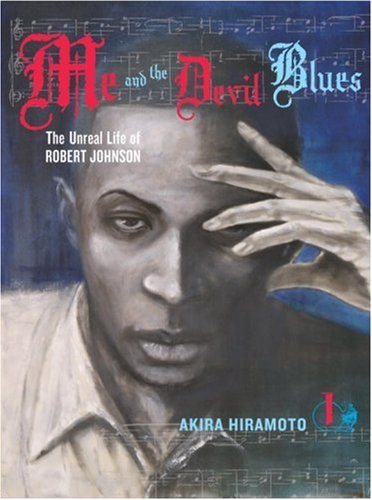
34:00
“People are jerking off to this, 100%.”
Christopher Butcher, on RaW Hero Vol 1
36:00 I think this sort of thing doesn’t really exist in published (printed) comics anymore. I think there used to be more of this sort of thing, people used to cite Phil and Kaja Foglio’s XXXenophile all the time. Though that’s even a step too far? Maybe it’s closest to the furry comics that Radio published, a kink or a fetish on display but telling a story that wasn’t always explicit, just sexy and out there?
[Deb:] For our more manga-centric listeners out there, Chip mentions Adam Hughes and Frank Cho, two American comics creators who are influenced by American pin-up girl art, to put it politely.
Maybe the closest we get, as mentioned in a few minutes, is Stepan Sejic’s original graphic novel series Sunstone, a fantasy BDSM story with two hot ladies in the lead role. A 7th volume just released in May of 2021, so I think it’s an ongoing concern too, good for them.
I do want to point out that Europe, specifically the French and Italian industries, have all kinds of ‘soft-core’ sexy comics on the level of RaW Hero, but these are rarely translated. Maybe the closest we get is the work of someone like Mirka Adolfino, who does series like Mercy, Unnatural, and Un/Sacred. If you’re someone who liked RaW Hero and wanted a sort of “Western” equivalent, here you go. 🙂
37:54 Manga Erotics F., the only manga magazine in which I have actually appeared (I was drawn into it by both Usamaru Furuya and Natsume Ono. Yes, that’s weird.) Founded by Dance Til Tomorrow manga creator Naoki Yamamoto, it was published by Japanese publisher Ohta Books for 88 issues, from 2001 to 2014. While it stopped print publication, several serials did move online to Ohta Books’ webcomics portal, where new chapters of titles very much in the spirit of Manga Erotics F continue to be serialized. I should note that the description of Manga Erotics F I mentioned in the episode, that it was a magazine founded for artsy comics makers to explore erotic ideas, kinks, etc., was told to me directly by the editor of the magazine, since that fact doesn’t seem to be in Wikipedia. Neat.
As mentioned, a ton of books were licensed and published by Erotics F, it was a series that punched waaaay above it’s weight class when it came to foreign publishing. Inio Asano’s A Girl on the Shore, Usumaru Furuya’s Lychee Light Club, Jiro Matsumoto’s Velveteen & Mandala, Natsume Ono’s Ristorante Paradiso, Takako Shimura’s Sweet Blue Flowers, a pretty good run. They even published a tankobon in Japan by Wave, Listen To Me!’s Hiroaki Samura, that… probably won’t be published in English.
38:00 [Deb:] Let’s give a shout out to Iron Circus publisher Spike Trotman and her super-successful, Kickstarter-funded adult comics anthology, Smut Peddler. Iron Circus also publishes many fine, fine NSFW comics for grown-ups.
39:50
“Despair is the sexiest of all.”
David Brothers
40:00 Penthouse Comix… I mean, the onbvious answer to David’s question is “Well it’s Comix with an ‘X’, so no, it always intended to be porn. And it was, not that there’s anything wrong with that. The most notable thing was, at the time, the page rate for comix appearing in the magazine was the highest page rate ever paid for comics. Since then, creators like the late Michael Turner, DC VP Jim Lee, and others besides have topped it, but going and doing some smutty comics for Penthouse paid very, very well, and that’s why top creators like Adam Hughes, Kevin Nowlan, Milo Manara, Richard Corben, and Gray morrow (amongst many more) contributed. The series ran for 32 issues in North America, but continued long afterwards internationally.
It’s strange that, given the rush to reprint ‘classic’ material in the last decade by companies like IDW and Dark Horse that there isn’t a ‘Best of Penthouse Comix’ collection out there. I mean, someone must own the rights to that work…?
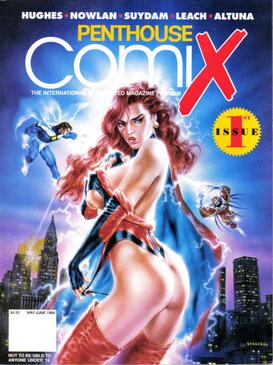
41:25 Chip is referring to his series with Kris Anka and Matt Wilson, The White Trees, published by Image Comics. There’s a pretty good orgy in there.
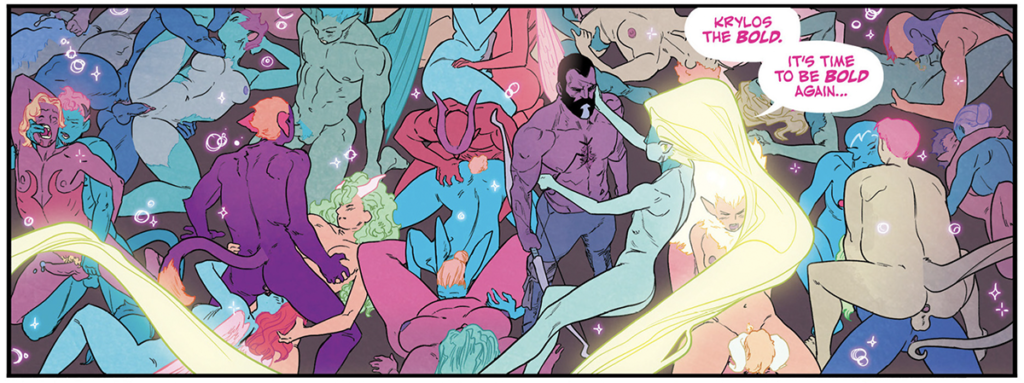
42:00 Meanwhile, Chip ALSO had a bit of sexy-times fun with this series Sex Criminals, and his partner on Howard The Duck, Joe Quinones’, turned in this variant cover for the series. I THINK these were never supposed to be revealed online, and Chip HASSLED* me when I asked for it… but I only asked for it because he specifically told me to put it into the show notes, so it’s his own fault.
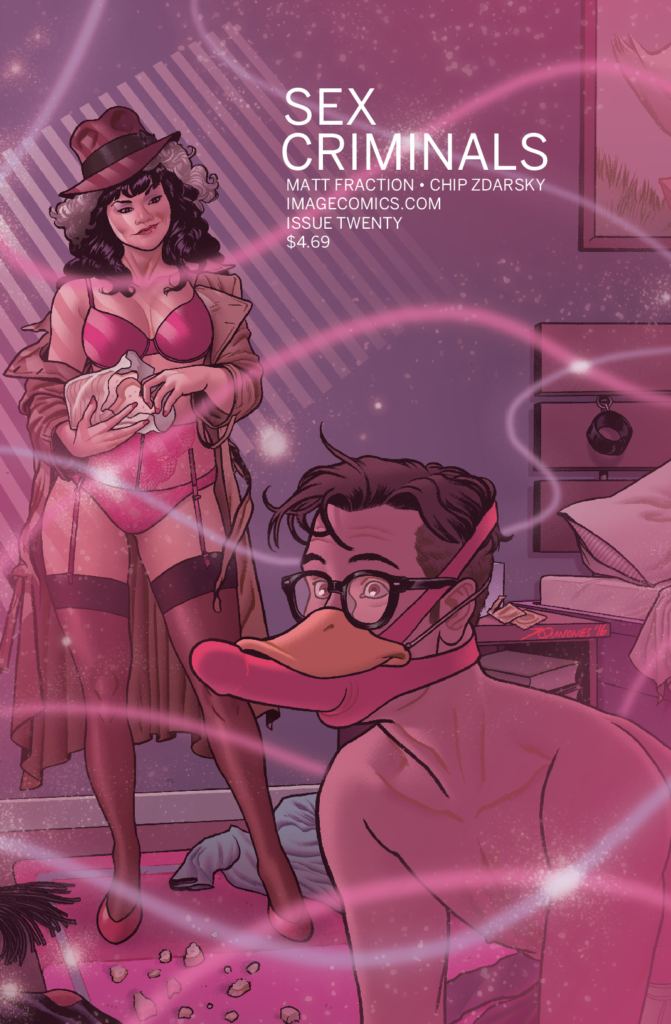
47:30 Razorback, aka Buford Hollis, joined “The 50-State Initiative.” He was never a member of (or mind-controlled by) The Serpent Society. My bad.
49:00 Kurt Hassler is the president of Yen Press, and makes many of the decisions on what Yen Press licensed from Japan for publication in North America.
49:30 American pervy stuff comes out of a tradition of cheesecake. This particular title comes out of a tradition of “Wouldn’t it be sexy if you felt awful?” It’s an acquired taste, but it is so, so prevalent in anime and manga spaces if you dig even a little. This whole series is like the Japanese manga/anime expression of a super-deformed character crying while they’re turned on, out of deep shame for their horniness. Often around ‘gay’ material too. I wish I could find an image for you here, but that string of words turns up a lot of images, none of which are useful. If I come across one at some point in the future, I’ll come back and edit that picture in. Anyway, this whole manga is Down Bad, as the kids today say, as is this genre.
51:15 And finally, to really knock this particular set of show-notes out of the park, here’s that final scene that Chip mentions, with the mystery woman about to sit directly on a our hero’s face, and him being terrified.
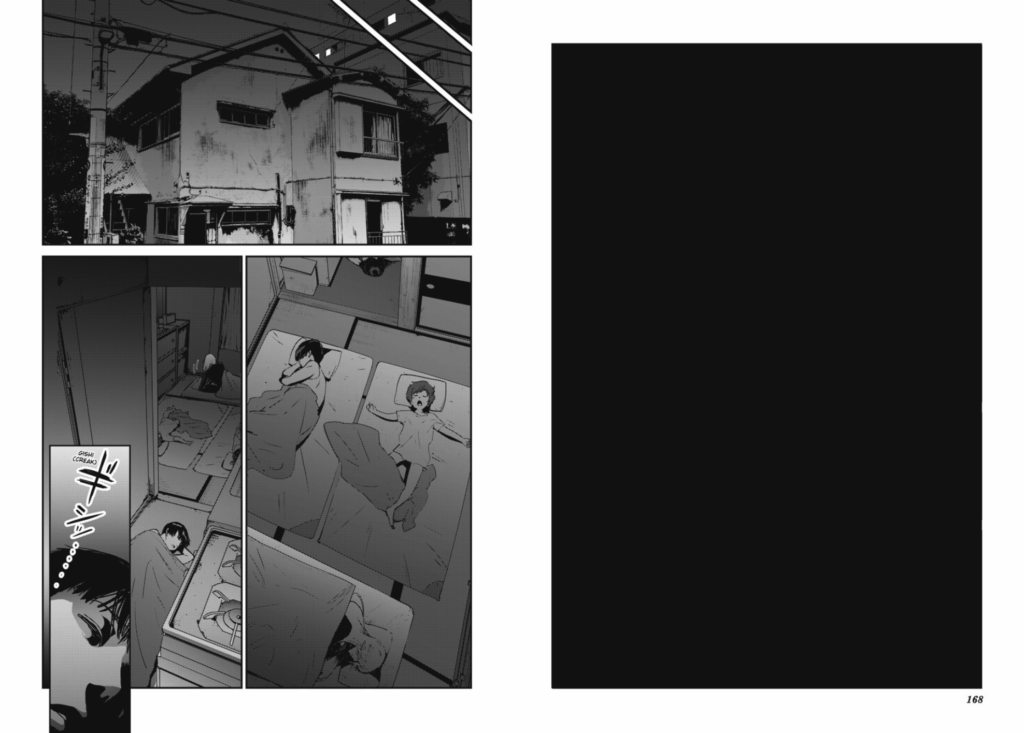
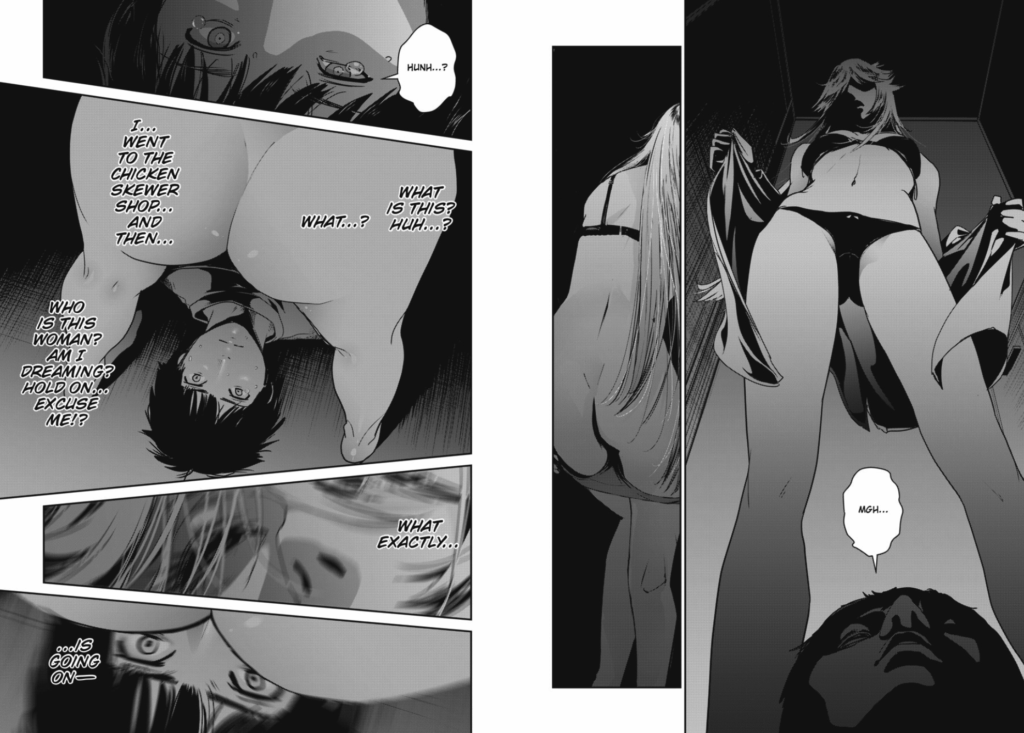
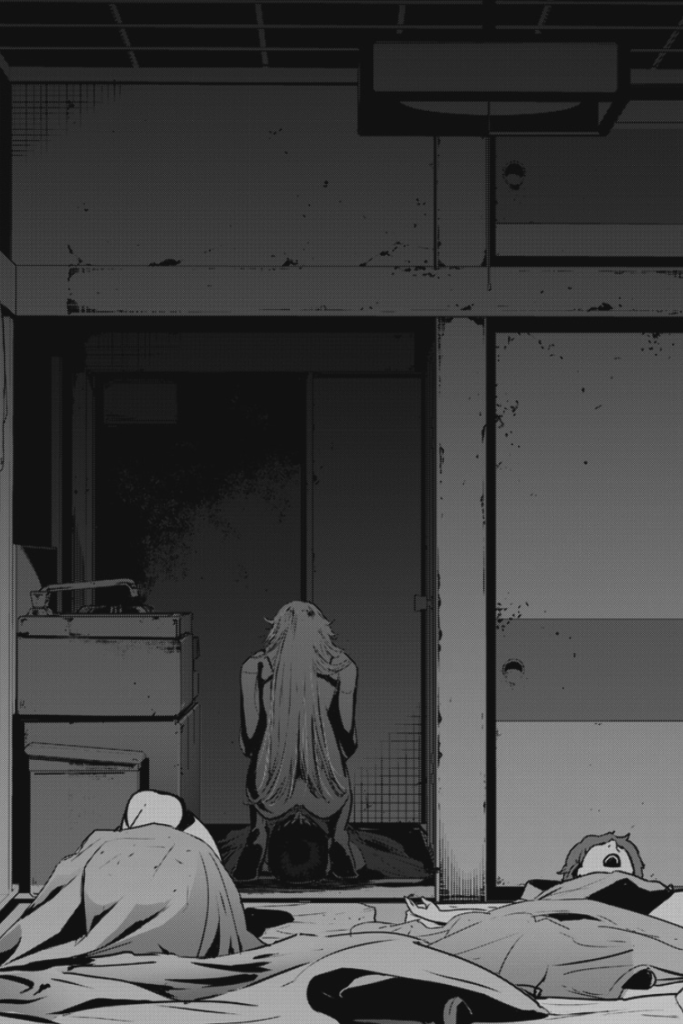
The beginning of RaW Hero volume 2, that follows 1 second after where this scene ends, is actually laugh out loud funny. Spoilers for volume 2.
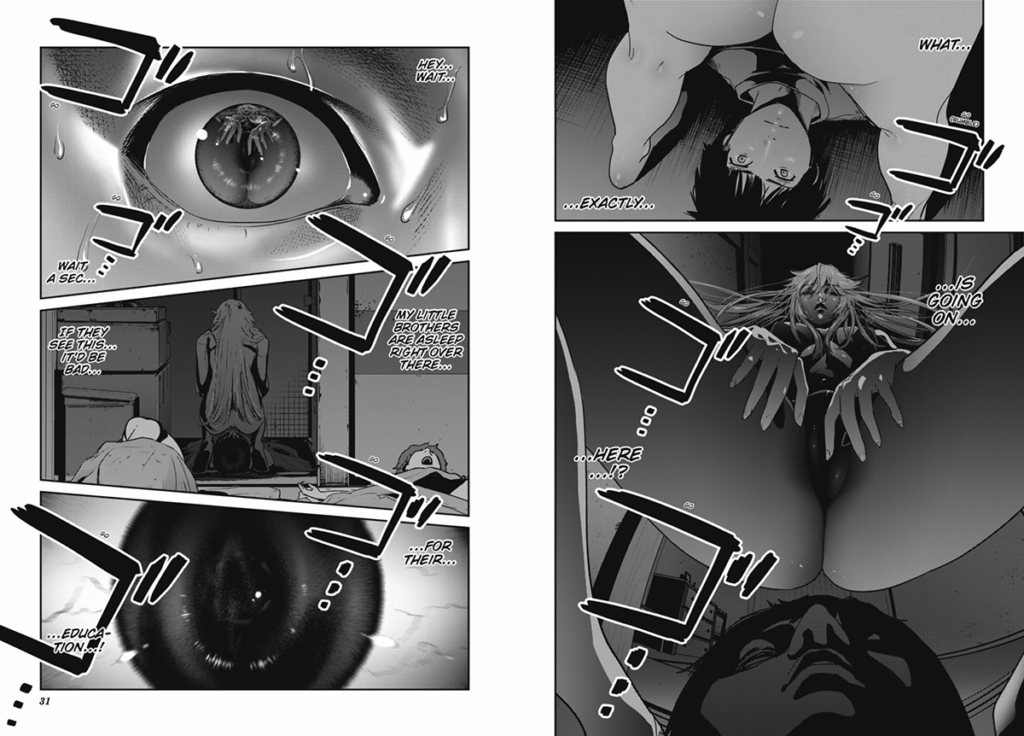
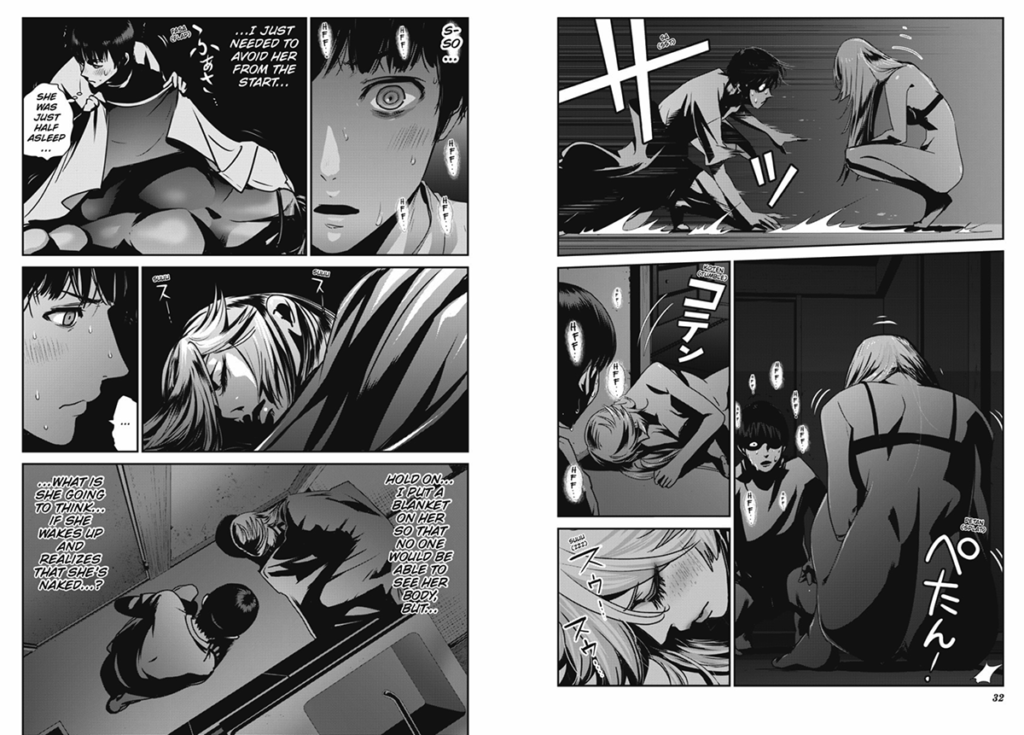
RaW Hero, everybody.
54:54 THE BREAK! Please remember that after this point all time-stamps are approximate due to dynamic advertisement insertion.
55:45 Here’s this week’s question!
Hey @mangasplaining are there any notable exceptions of mangaka being visibly influenced by western superhero comics?
@Thinknuofficial, Twitter.com
56:00 Deb mentions Kohei Horokoshi, author of My Hero Academia, as being very influenced by American comic books, and films. A quick google search found this amazing suite of fan-art by Horokoshi, all produced before My Hero Academia was released. It’s intresting that when MHA hit,
58:08 The God of Sumo is named Nomi no Sukune, and he is thought to have existed in approximately 23 B.C. You can read more about him at the Wiki. Here’s that photo from a shrine to Sumo in Fukuoka, Japan, and you can see, dude is ripped and big.
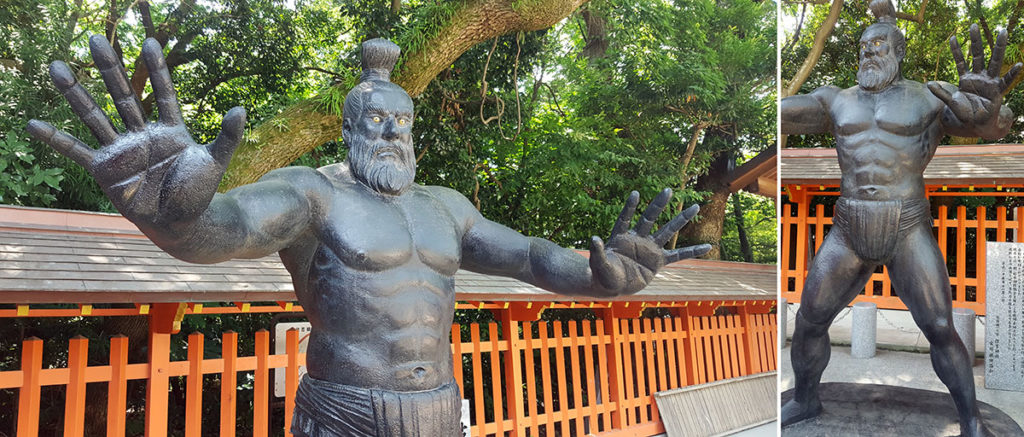
There’s also the gods Raijin and Fujin, which are usually portrayed in sculpture as incredibly muscular. The two statues at Tokyo’s popular Sensoji Temple in Asakusa show the gods of lightning and thunder as buff with big bellies, so these sorts of hypermuscular takes totally do exist… they just aren’t very prevalent in contemporary Japanese pop culture.
58:50 Doug Ramsey (aka Cypher) is a mutant character first introduced in Marvel’s New Mutants comic series. A slight, shy boy, his mutant power was the ability to communicate in any language, which was meant to show at the time (1983) that not all mutant powers were for fighting flying and what-not. After a brief stint on the bad guys’ team, the character joined the New Mutants (junior X-Men), and in an early adventure encountered an alien, Warlock, a creature that was “TechnoOrganic.” He communicated with them, inviting them to join the team, and they became great freinds. He would eventually sacrifice himself saving his teammate Wolfsbane. Eventually some baddies dug up his body (lol) and reanimated him using a techno organic virus. Eventually the good guys saved him, restored his soul, and he rejoined the team through a bunch of other adventures. I can’t believe I even typed up this much, frankly, but Chip did let me use the Quinones cover so I guess this is the least I can do.
1:00:30 Yeah, I’ve always thought that the two sides of the character All-Might are supposed to be based on American superhero comics, and American indie comics. I get real Johnny the Homocidal Maniac vibes from the image on the right below. I know Jhonen Vasquez’s Invader Zim made it to Japan, not sure if his other comics ever did in any meaningful way? But really interesting to see this dichotomy. If someone who knows Horokoshi-sensei reads this, please ask him for me. 😉
1:01:10 I just wanted to note that American comics, both untranslated and occasionally translated into Japanese, have existed in waves since the U.S. occupation following World War II. There’s a really interesting thread that connects the comic books of American G.I.s with early influences on the work of Tezuka that can maybe never be proven. I should mention this next time we talk about Tezuka. But yeah, check out this (huge) essay from Ryan Holmberg at TCJ about the U.S. Comics influence on Tezuka. They’ve never been even close to as popular as domestically produced comics, but there is a strong fandom for the stories that has only expanded following the rise of superhero movies globally. There have been many high-profile translations throughout the years, but sales, even for the biggest superhero books, tend to be in the 3000-5000 copy range. Even with media tie-ins. Just wanted to clarify.
That said, there have been a number of attempts at Cross-Cultural Pollination.
[Deb:] International Manga Festa brought together superstars of American comics and French BD together with Japanese manga creators for “talk live” sessions at Comitia, the Tokyo indie comics festival we’ve mentioned in the BL Metamorphosis episodes. Sadly, it seems like the event is on hiatus for now.
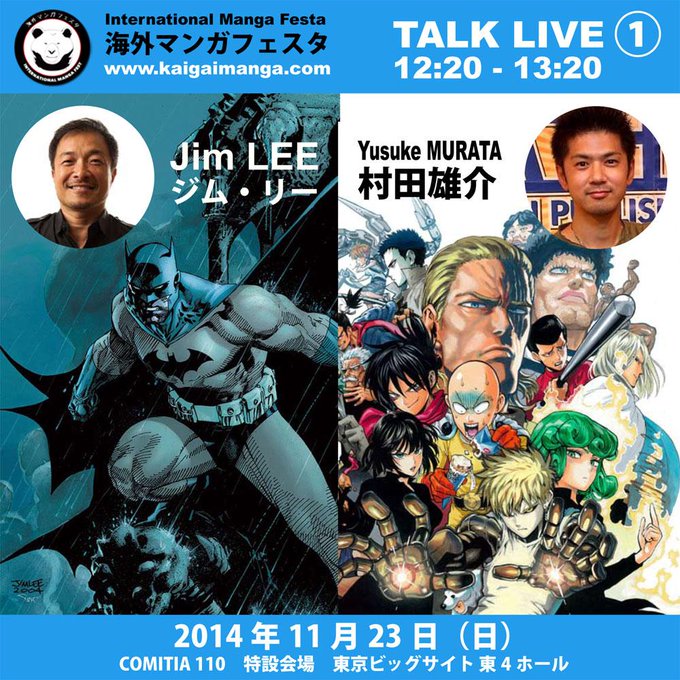
[Deb:] Here’s my photos from 2014, when Jim Lee and Yusuke Murata both drew Batman (with translation by friend of Mangasplaining Akihide Yanagi). The Batman logo is a little odd, because Murata apparently only had the Batman 75th anniversary logo to refer to. Also, Yusuke Murata is TALL.
1:01:25 Wow, I really gave myself a lot of work this episode.
Nouvelle Manga is a comics literary movement that tried to build bridges between French BD and Japanese Manga. The core idea is that French BD is very focused on SF and genre work, even though French film exploits everyday life to great affect, where Japanese manga has tons of great ‘everyday lifestyle’ manga, but that sort of work only rarely gets translated abroad, with SF and genre material leading the way. You can read the whole manifesto(!) here at author Frederic Boilet’s old website, it’s interesting, and it actually really affected my thinking about manga back when I read it in the mid-2000s. The Wikipedia for the movement lists about a dozen books but there were maybe 2 dozen total, and really, the idea didn’t so much die as the publication of these books and these exchanges had a transformative impact on French BD. Whether it had much of an impact on manga is perhaps debatable. We got some great works out of it though, and many more excellent works down the line from those creators.
Probably the book I like the best is Japan as Viewed by 17 Creators, an anthology (I love anthologies) that asks 8 Japanese mangaka to write a story about their hometown, 8 French BD creators to tell a story about a town they’ve visited in Japan, and the 17th creator being Frenchman-in-Japan Boilet. There’s some amazing creators in this book, I haven’t read it in years and I’m really tempted to pull it off my shelf and give it a read right now, but it’s getting very late and these show notes still aren’t done.
Still, worth a buy if you see it, and I think Amazon has copies.
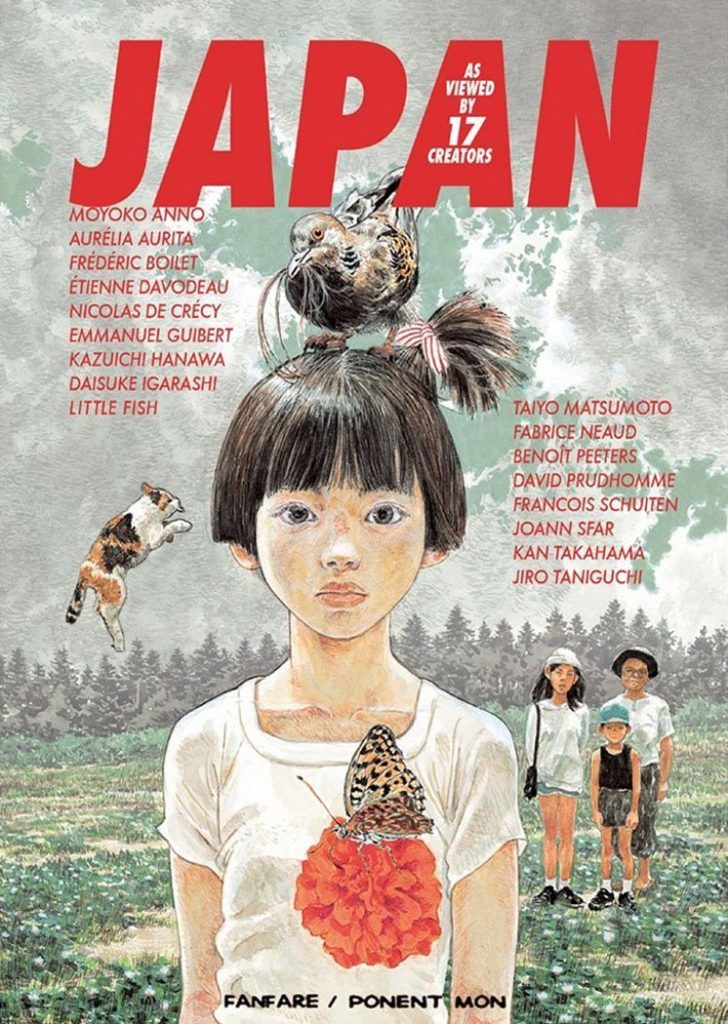
1:02:30 So yeah. Minetaro Mochizuki’s work went through a huge transformation. This is his relatively popular horror/thriller series Dragon Head, from the mid-2000s:
…and this is his series Chiisakobe, published by excellent French Comics Publisher Lezard Noir.
It’s a pretty striking transformation, going from survival horror to everyday life. I feel like the hair and beard on volume 3 has kind of a Charles Burns thing going on, FWIW, it’s not all Tomine and Clowes. But I think it’s kind of… amazing….? To see an artist discover art that sets his whole world on fire, internalize that, and start telling completely different types of stories. I hope this didn’t come across as throwing shade, I think it’s honestly remarkable (and the work looks great). It’s just so striking, I can’t think of that many artistic transitions that have happened in this way.
1:04:15 As Deb mentions, Mochizuki’s only book in print in English is his adaptation of the Wes Anderson movie Isle of Dogs, published in Japan by Kodansha (first!) and then translated and published in English from Dark Horse.
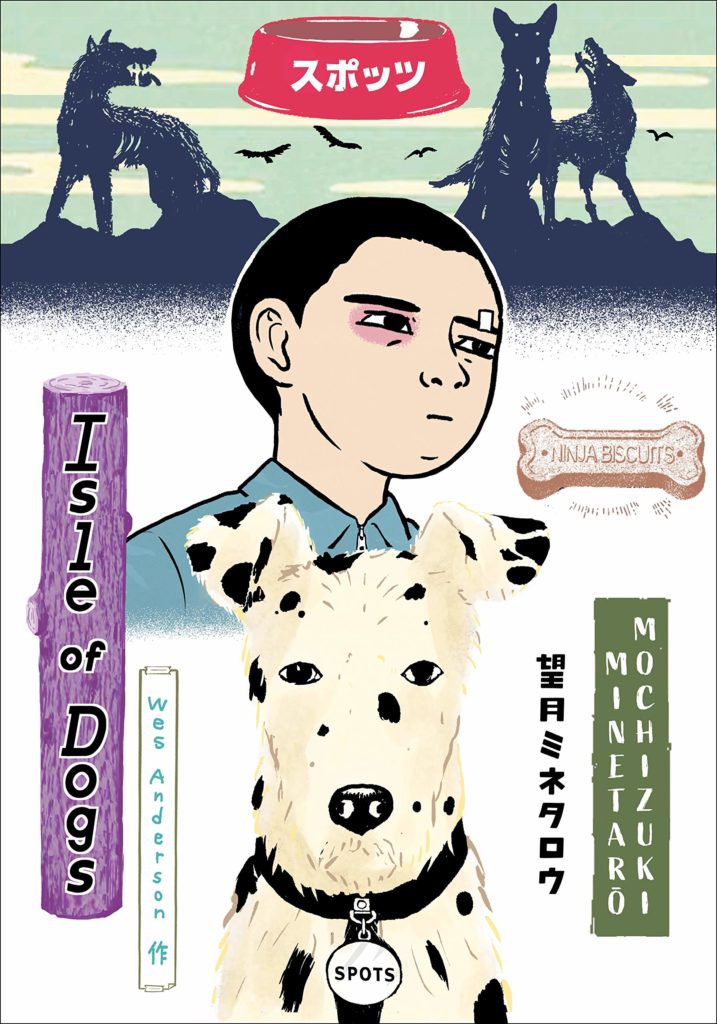
1:05:45 So yeah, Atsushi Kaneko is awesome. It’s practically a crime he hasn’t been translated to English yet. Take a look at these book covers and tell me you don’t want to read more of this.
[Deb:] Back in the day, Digital Manga Publishing put out English editions of Bambi and her Pink Gun by Atsushi Kaneko. It’s VERY out of print, but if you’re intrigued, go seek it out. I also met Kaneko-sensei at a past Kaigai Manga Festa, where he was signing copies of The Tipping Point, an anthology of French and Japanese comics creators, including Keiichi Koike (Heaven’s Door) Naoki Urasawa (20th Century Boys) and Enki Bilal (Nikopol). It’s available from Humanoids.
1:07:10 David brings up this Battle Angel Alita illustration by Yukito Kushiro, which includes swipes from Frank Miller and Lynn Varley’s Elektra Lives Again, as found on Twitter. Here’s the image:
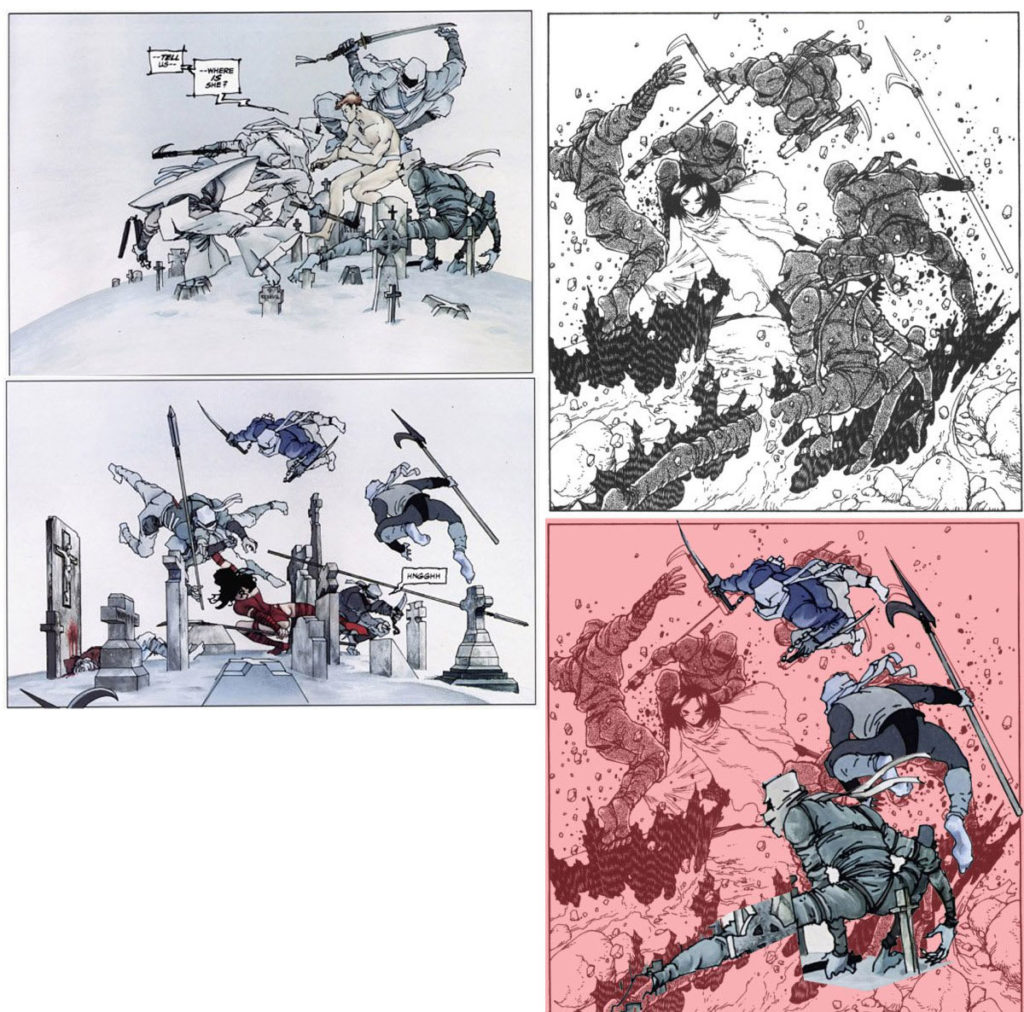
One thing we didn’t mention, that maybe we should have, was that Kishiro created a one-volume spin-off to Battle Angel Alita called Ashen Victor, that was a book-length tribute to the artwork of Frank Miller from his Sin City days. The series includes a couple of direct swipes from Miller, but the style makes it kind of… obvious. Anyway, if you’ve got that new big hardcover omnibus collection of Alita, it’s collected in the 5th volume.
1:08:30 David drops the bombshell that Todd McFarlane photocopied in backgrounds from Katsuhiro Otomo’s AKIRA for his (early) work on Batman: Year Two for DC Comics. Here’s a link to Erik Larsen’s post on Facebook. Just remember if you’re going to join a public group: Don’t be a dick.
1:09:00 Now It’s Time For Shout-Outs!
Chip shouts out Alex Segura’s forthcoming novel Secret Identity, arriving on store shelves in March 2022.
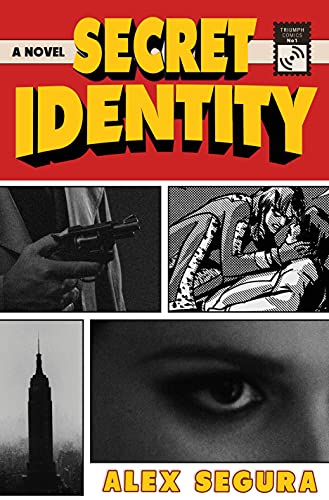
Deb shouts out a new Webtoon, Batman: Wayne Family Adventures, by Starbite and CRC Payne. David compares it to Hannah Blumenreich’s Spider-Man comics, which I think we’ve linked here before.
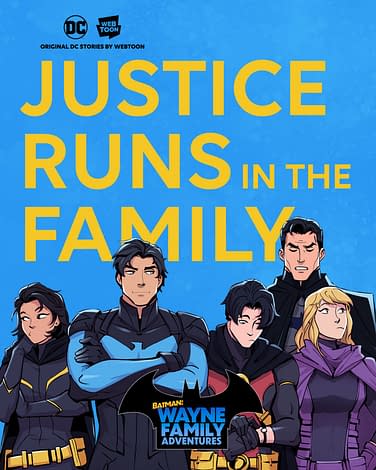
Christopher shouts out the new Animal Crossing 2.0 expansion. It’s just… nice.

David shouts out the anime film Mobile Suit Gundam: Char’s Counterattack, streaming on Netflix right now. I just found this trailer, and Optimus Prime does the voiceover! RAD!
…and that’s this week’s episode!
As David notes in the closing bit, we always recommend checking out comicshoplocator.com or your local library for print and digital lending options for your manga reading… but next week we’re reading Look Back, by Tatsuki Fujimoto, and that’s exclusive to Shonen Jump.
Check out Mangasplaining theme song composer D.A.D.S. on Spotify!
Thanks for reading!
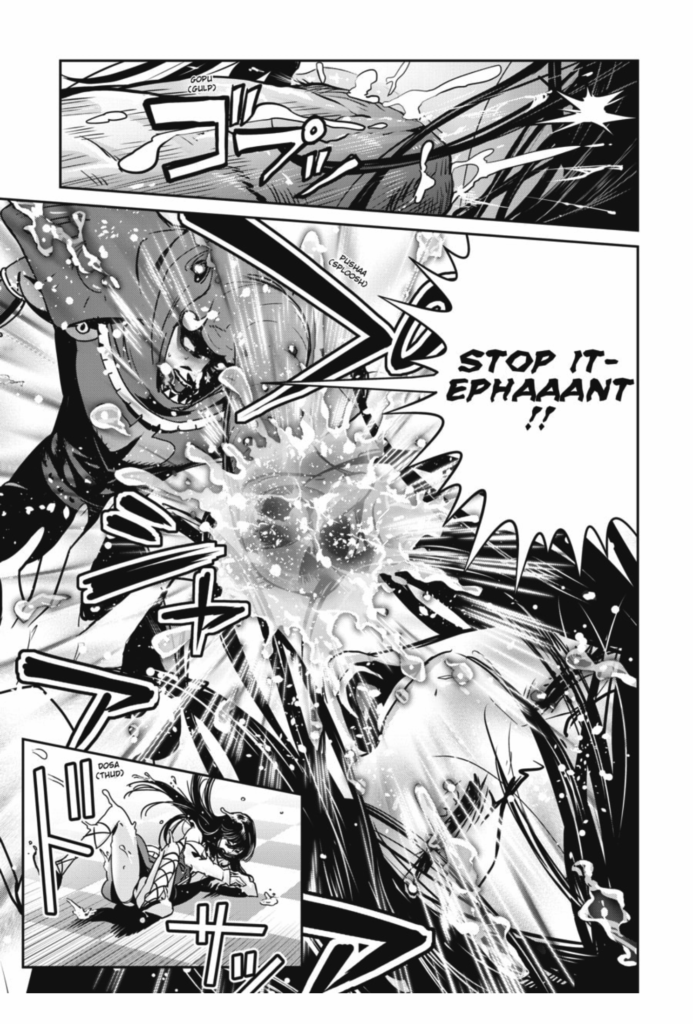


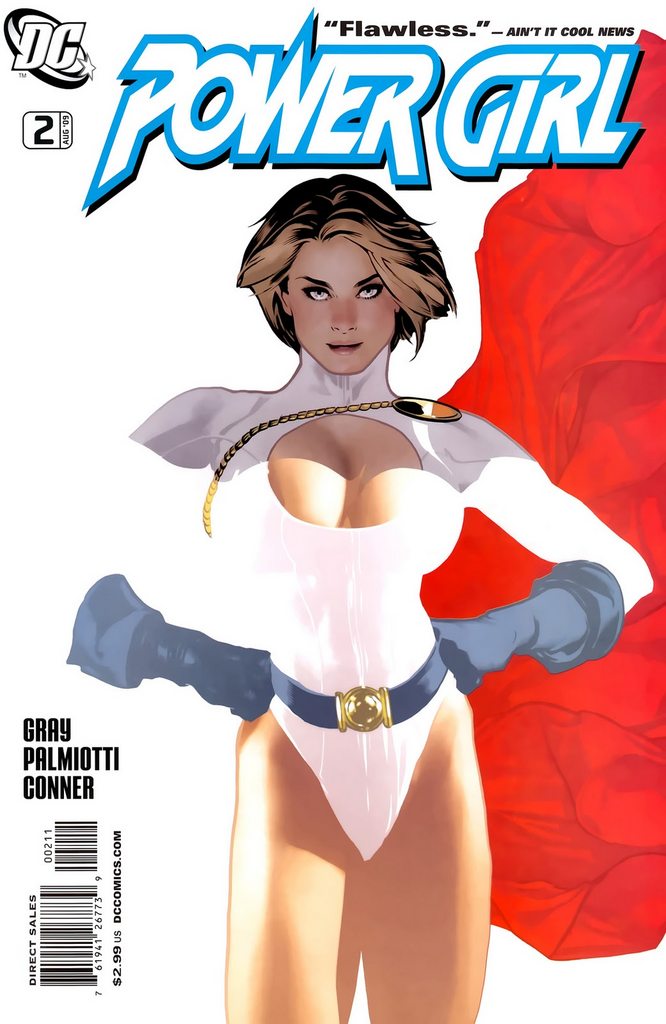
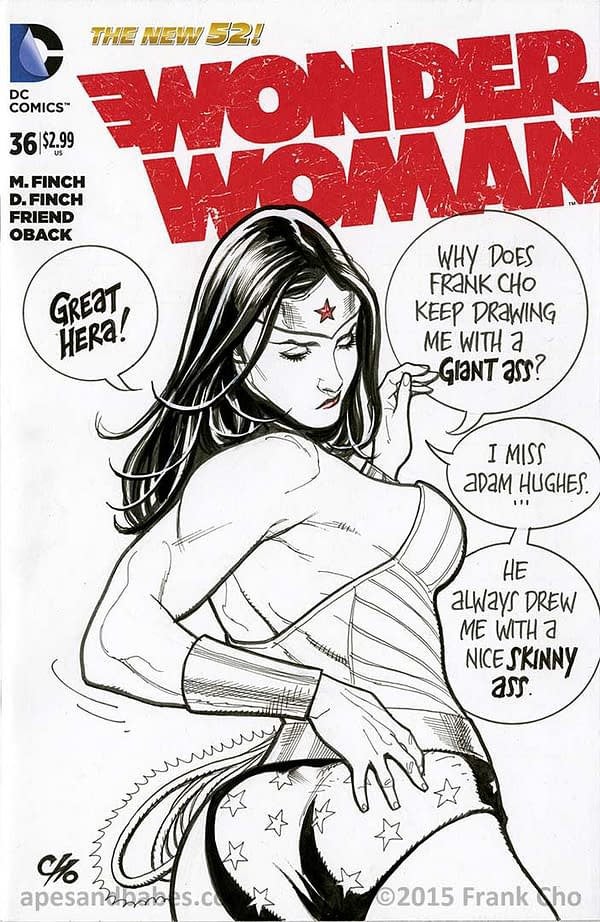


















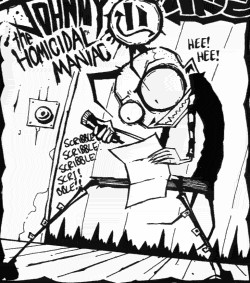















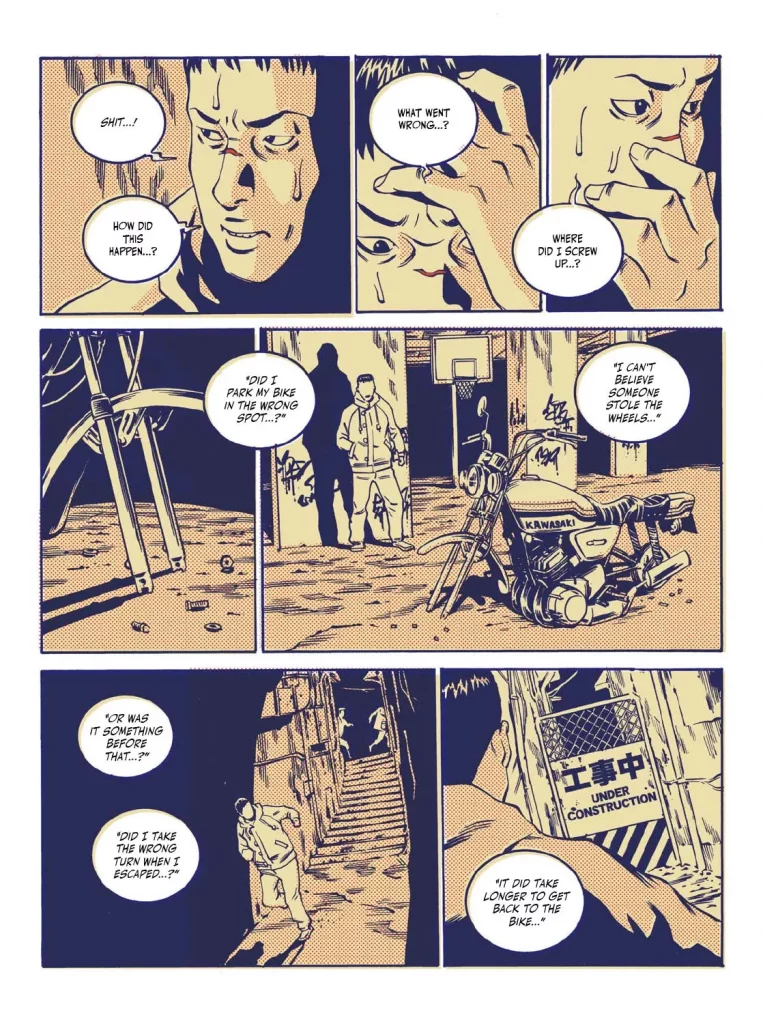





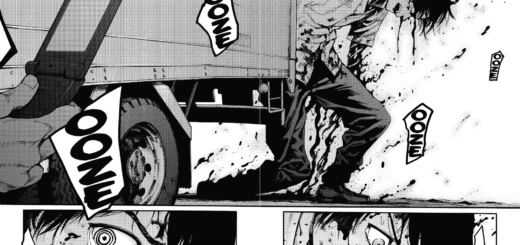
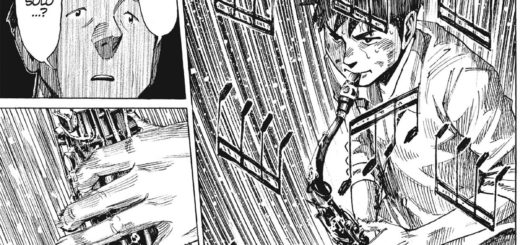
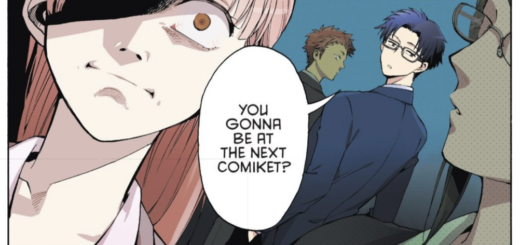
This is your best episode yet! Man, I laughed. Of the many reasons to love manga as a graphic medium, it’s the high percentage of trash I dig most. And by trash, I’m not talking about some insipid 4-panel cartoon on the back of a Cracker Jack box, but trash as in smelly, low brow, bad taste, all offensive, bat shit insane, cocaine fueled fever, bottom floating gutter sewage that we just love chowing down on.
With excessive consumerism seemingly unstoppable globally, supplanting all that is good wiping out any unique culture and replacing it with some collective vision of Capitalism, we’re going to get trash. After all, it is trash that defines consumerism, nay… Capitalism. And so, what better trash to embrace than manga trash? I forward that manga trash is at least better than anime trash, movie trash, music trash, celebrity trash, church trash, government trash, Walmart trash, Apple trash, and especially food trash (hell, most of the packaged food we get in stores are actually, trash. No, for real). Manga trash is more subversive, bonkers, and less calories. Like our great prophet Kaneda says: good for health, bad for education.
I hope you guys keep reading RAW HERO. Looking around, it’s truly great to see how much manga trash that is available right now, something I’d have never imagined in the 80s. In fact, I’m surprised how much lowbrow stuff had been published over the last 30 years (ok, half of them were penned by Koike Kazuo… you know the ones I’m talking about, haha). Still, sadly, there were many gutter gems that would never get the kind of attention they deserved here in the West. Oh, what I wouldn’t give to see some of Tokuhiro Masaya’s outrageous gag manga from the 80s, i.e. SHAPE UP RAN, LORD OF THE JUNGLE TARCHAN, and FUDOSHI DETECTIVE KEN CHAN… I laughed so hard reading it one time at a ramen joint in Denver noodles came shooting out my nose. It would also be great to see the horror meister Umezu Kazuo‘s irrelevant and totally scatological title, MAKOTO CHAN. It’s one of the grossest titles I’d ever read where this kid keeps getting into situations involving feces, and it was serialized (off and on) in a shounen magazine! I mean, Umezu arguably invented the whole modern horror manga genre single-handedly. This guy is contemporary to some of the giants of manga in the 60s and 70s such as like Chiba Tetsuya (TOMORROW JOE, ORE WA TEPPEI, and R.I.P. btw) and Mizuki Shigeru for crying out loud. Man, Japanese manga embraces trash.
Lastly, in reading RAW HERO, I’m reminded of the mandate that for any art to be vibrant, the boundaries must be pushed, broken, redrawn, and repeat. Even try-and-true old-skool shounen-fighting formula like DRAGONBAL and others, new titles are ever bucking and pounding against the old gate, everything from art to story to paneling to sound effect to the visual grammar, (a few recently popular examples: (your) DANDADAN, KAIJU #8, JUJUTSU KAISEN, CHAINSAW MAN, but also DOROHEDORO, ATTACK ON TITAN, DEMON SLAYER, ONE PUNCH MAN, and the surreal BIBLIOMANIA, etc). Often, the ones at that pushy vanguard are the trash manga… and by that extension and at the very tip (no pun intended), ero-manga.
I’m drawn to ero-manga because as manga is a complete package, I must embrace all: the good, the bad, and the absolutely filthy. Sometimes I love it just for the erotic art, sometimes a title blows my mind to smithereens no less different than how Raw Hero or one of these super dumb but super fun (hence sublime) isekai stories does. I don’t know if your super team will ever venture into that blue zone in your podcast, but if you ever do, might I suggest checking out Kimi Rito’s HISTORY OF HENTAI MANGA translated and published by Fakku? It’s available on Amazon even. I’m really glad it’s coming out in English since my Japanese just sucks. It’s relatively contemporary (I believe it was pub in 2019 or around there). It’s not a manga, but it’s a great read for anyone who had witnessed the many evolution in ero-manga over the last 40 years. There’s always been erotic expression throughout human history, but ero-manga is unique even when compared to other erotic art, including western erotic comics. So for a contemporary art form to survive that long, and will seemingly continue to do so even within an internet world filled with porn wall to wall, ero-manga really deserves examination.
Sorry for the long essay. I just love RAW HERO (and yes! PRISON SCHOOL) that much.
Thanks for the very long comment! It makes up for the… complete lack of other comments. Haha, not every episode is for everyone, but we’re glad this one was for YOU.
Agree with BaccaB that this episode was really fun. I think the choice of Raw Hero forced the four of you into a direct discussion of the topics you skirted around in the Dandadan episode. It’s great that such a “trashy” manga can engender such a serious discussion.
Still on the fence on whether or not this manga is for me. I do love a good trashy comic, but I think I’m still reeling from reading Cutey Honey earlier this year. Seems you can get second-hand copies pretty cheap, so I may check it out…after I finish “City.”
The question of Western comics creators influencing manga creators was a good one, and there’s a lot to unpack there. Moebius definitely stands out as an example. Your right that Marvel/DC comics in translation were hard to come by in the olden days, but from the mid-90s onward, they were more widely available. (I recently saw the complete Japanese version of Spawn on sale on an auction site.) I know Akihito Yoshitomi, creator of Eat-Man, and other late ’90s/early ’00s manga-ka were big Jim Lee fans, but they’re more contemporaries, so it’s difficult to see a direct influence. One weird roundabout influence on certain creators was the Capcom fighting game artists of the ’90s, like Akiman, Bengus, Kinu Nishimura, Daigo Ikeno, and Edayan. Because of the various Marvel and Marvel vs. fighting games and the accompanying artwork, you had a lot of manga creators and Japanese people in general got their first introduction to Western character design aesthetics through video games. There were a number of artists at the time seeking out Jim Lee or Image Founders comics, but you could argue it was more out of professional interest than already successful manga-ka looking for inspiration.
Akira Toriyama definitely likes Superman, he had a parody character of him in Dr. Slump, and even made Son Goku’s backstory akin to Superman’s. How much of that came from the comics or the movies, is probably up for debate. I’ve never seen Toriyama reference a Curt Swan or Neal Adams Superman as an influence.
And speaking of movies, U.S. movies have always been super influential on manga-ka. You can see that most blatantly in Fist of the North Star with its homages and pastiches of Mad Max, Terminator, and Aliens. (In the second half of the series there’s a tower on a island that just looks like it was straight-up constructed out of the carcases of the xenomorph.) You can already see Marvel movies influencing a lot of pop culture in Japan (movies, TV shows, and especially games). It’s not long before some young artist who grew up on a diet of MCU films hits it big in the world of manga. Of course, that goes back to the original question: MCU influence is NOT the same thing as being influenced by Gil Kane or Art Adams or Humberto Ramos. With Marvel/DC’s musical chairs creative teams, it’s hard to imagine any single creator having an artistic influence greater than the characters themselves. I could be wrong, but I think the days of a Moebius or Frank Miller or Jim Lee influencing manga might be a thing of the past. But that prognosis is based on a limited perception influenced by the traditional constraints of the publishing industry. Who knows what artists are encountering online. Could we see a Japanese humor comic completely influenced by Achewood in five years time? Anything is possible.
Hey guys! What a great episode. I always have a great time listening to you guys being both funny and informative.
Something I thought you might find interesting, as I’m reading manga mostly in French these days, is that the translators here had a slightly different approach to the elephant character, in that he ends every sentence with a phonetic elephant-like ‘BRRRAAAAOOOOUUUU’ rather than what happens in the English version. Not quite as weird, maybe, but still extremely funny.
This episode had me laughing so much.
– Thank you all